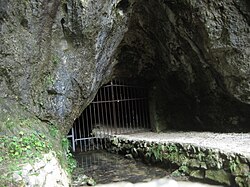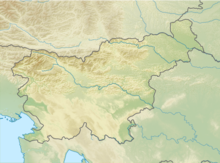| Hell Cave | |
|---|---|
 Entrance to the cave Entrance to the cave | |
 | |
| Location | Zalog pri Šempetru, Slovenia |
| Coordinates | 46°17′23.28″N 15°7′58.8″E / 46.2898000°N 15.133000°E / 46.2898000; 15.133000 |
| Length | 1,159 m |
| Discovery | 1860 |
| Geology | Karst |
Hell Cave (Slovene: Jama Pekel) is a karst cave in the settlement of Zalog pri Šempetru in Slovenia.
Name
Across Slovenia there are many oronyms, regional names, and microtoponyms named Pekel or 'hell'. In folk geography, the name was used to metaphorically designate chasms, caves, shafts and other narrow, dark places; for example, in Kropa there is an oeconym Pekel originally referring to a blacksmith's shop. Semantically related names in Slovenia include Devil's Hole (Slovene: Vragova luknja) in the settlement of Okrog and Devil's Ravine (Slovene: Hudičev graben) in the settlement of Parož. The cave's dark, black entrance inspired the idea that the Devil lived inside.
Other stories of the name's origin say that one of the rocks near the entrance was thought to look like the Devil or that warm water vapour drifting from the cave in the winter had an eerie effect. See also Hell Gorge, Pekel, Maribor, and Pekel, Trebnje.
Description
The cave is 1,159 m (3,802 ft) long and has two levels. Peklenščica Creek runs through the caverns of the lower part of the cave and comes bursting out of a siphon as the highest-elevation accessible subterranean waterfall in Slovenia. The upper part of the cave is dry, but full of cave formations.
History
The cave is more than three million years old. Finds of human bones in the cave prove that the cave was used as a shelter by these early inhabitants of Europe. Wooden footbridges were set up in the cave in 1860, making it accessible to visitors. The cave became better known between 1860 and 1870, when it was explored by Anton Franz Reibenschuh, a professor from Graz. It was also explored at the end of the 19th century by Ivan Kač, a municipal secretary in Žalec.
The speleologist Anton Suwa died in the cave in 1969. In 1972 the cave was opened to the public and it was visited by 25,000 people the following year. It has been managed by the local tourist association since 1972.
References
- ^ Savnik, Roman (1976). Krajevni leksikon Slovenije, vol. 3. Ljubljana: Državna založba Slovenije. p. 539.
- Snoj, Marko. 2009. Etimološki slovar slovenskih zemljepisnih imen. Ljubljana: Modrijan and Založba ZRC, p. 303.
- ^ "Šempeter Tourist Association: History of Pekel Cave". Archived from the original on 2013-06-13. Retrieved 2013-07-08.
- Slovenian Tourist Office site (in Slovene)
- Šempeter Tourist Association: Pekel Cave
- Zavod za kulturo, šport in turizem Žalec: Jama Pekel Archived 2013-07-08 at archive.today (in Slovene)
- Šempeter Tourist Association site
External links
 Media related to Hell Cave at Wikimedia Commons
Media related to Hell Cave at Wikimedia Commons
| Prehistoric cave sites, rock shelters and cave paintings | |||||||||||||||||||||||||||||||||||||||||||||||||||||||||||||||||||
|---|---|---|---|---|---|---|---|---|---|---|---|---|---|---|---|---|---|---|---|---|---|---|---|---|---|---|---|---|---|---|---|---|---|---|---|---|---|---|---|---|---|---|---|---|---|---|---|---|---|---|---|---|---|---|---|---|---|---|---|---|---|---|---|---|---|---|---|
| |||||||||||||||||||||||||||||||||||||||||||||||||||||||||||||||||||
| |||||||||||||||||||||||||||||||||||||||||||||||||||||||||||||||||||
| |||||||||||||||||||||||||||||||||||||||||||||||||||||||||||||||||||
| |||||||||||||||||||||||||||||||||||||||||||||||||||||||||||||||||||
| |||||||||||||||||||||||||||||||||||||||||||||||||||||||||||||||||||
